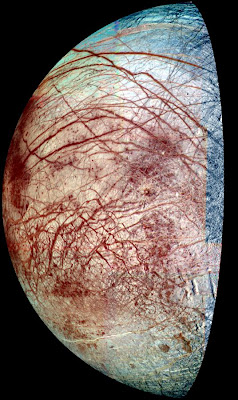 The frigid ice of Jupiter's moon Europa may be hiding more than a presumed ocean: it is likely the scene of some unexpectedly fast chemistry between water and sulfur dioxide at extremely cold temperatures. Although these molecules react easily as liquids—they are well-known ingredients of acid rain—Mark Loeffler and Reggie Hudson at NASA's Goddard Space Flight Center in Greenbelt, Md., now report that they react as ices with surprising speed and high yield at temperatures hundreds of degrees below freezing. Because the reaction occurs without the aid of radiation, it could take place throughout Europa's thick coating of ice—an outcome that would revamp current thinking about the chemistry and geology of this moon and perhaps others.
The frigid ice of Jupiter's moon Europa may be hiding more than a presumed ocean: it is likely the scene of some unexpectedly fast chemistry between water and sulfur dioxide at extremely cold temperatures. Although these molecules react easily as liquids—they are well-known ingredients of acid rain—Mark Loeffler and Reggie Hudson at NASA's Goddard Space Flight Center in Greenbelt, Md., now report that they react as ices with surprising speed and high yield at temperatures hundreds of degrees below freezing. Because the reaction occurs without the aid of radiation, it could take place throughout Europa's thick coating of ice—an outcome that would revamp current thinking about the chemistry and geology of this moon and perhaps others."When people talk about chemistry on Europa, they typically talk about reactions that are driven by radiation," says Goddard scientist Mark Loeffler, the first author on the paper being published Oct. 2 in Geophysical Research Letters. That's because the moon's temperature hovers around 86 to 130 Kelvin, or about –300 to –225 °F. In this extreme cold, most chemical reactions require an infusion of energy from radiation or light. On Europa, the energy comes from particles from Jupiter's radiation belts. Because most of those particles penetrate just fractions of an inch into the surface, models of Europa's chemistry typically stop there.
"Once you get below Europa's surface, it's cold and solid, and you normally don't expect things to happen very fast under those conditions," explains co-author Reggie Hudson, the Associate Lab Chief of Goddard's Astrochemistry Laboratory.
No comments:
Post a Comment